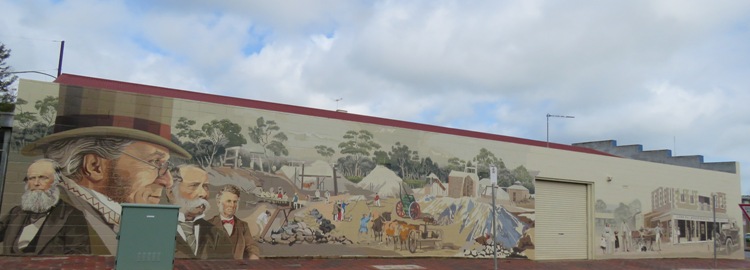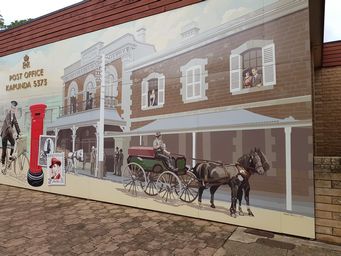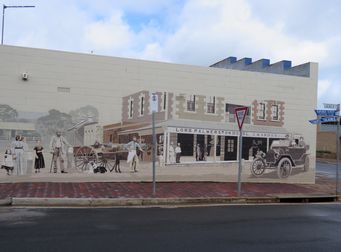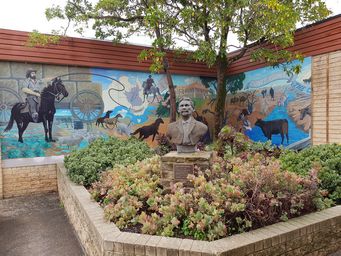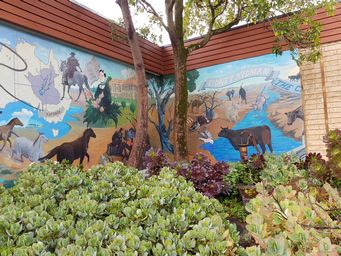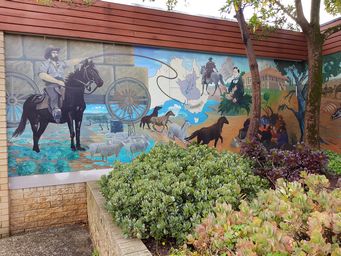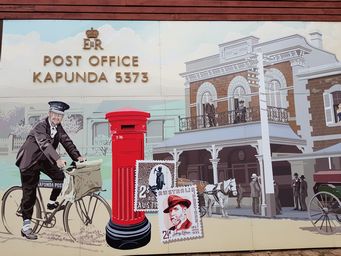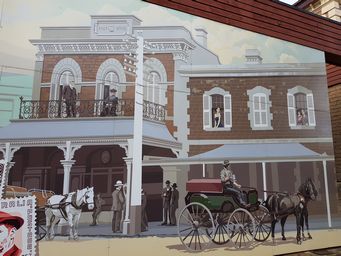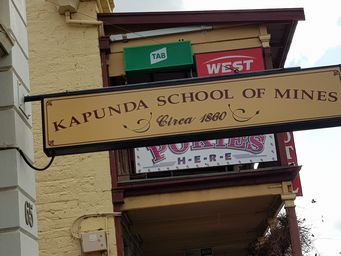Australia So Much to See
Auburn to Kapunda
The bust (above) is inscribed
Leaving Auburn, we headed to twelve kilometres to Saddleworth. Vineyards that dominated the Clare Valley continued, but interspersed
with farmland. A large modern agricultural services store amongst the old buildings indicated Saddleworth is a key agricultural
town.
James Masters took up an area of land from Riverton to Saddleworth and Auburn as a sheep run in 1840. He built
his house approximately a kilometre north of Riverton and called it Saddleworth Lodge, after his former hometown of Saddleworth in
Yorkshire, England. When copper was first mined at Burra, staging points were established approximately seven miles (approximately
11 kilometres) apart as this was the distance a bullock team could travel in a day. Joseph Dunn applied for a Publican's Licence
to open a new Saddleworth Lodge in March 1846, and it was granted on the 14th of March 1846.
Saddleworth features some very old
buildings. The Historical Society run a Museum is located in the old Siekmann and Moule wheat store built in 1859, the oldest
building still standing in Saddleworth and once the largest store north of Gawler. The museum houses and maintains the history
of Saddleworth and the nearby towns of Waterloo, Marrabel and Manoora. There is a three kilometre historic walk, linking Saddleworth’s
historic buildings.
Marrabel is a tiny town with the most prominent building being the hotel, which had closed earlier
in the year. On the south side of town, the Oddfellows Hall dated 1911 is attractive architecture and appears well maintained.
Marrabel was named by early settler John Marrabel, who laid out a town in 1859, naming in Marrabel. Visitors are attracted to
the annual Marrabel Rodeo, which takes place in October.
The former township of Hamilton now only has a farm house complex,
and a lovely old church with spire.
Allendale North has little but a Hotel, the Wheatsheaf Pub, which dates back to 1855. This is still operating.
Sir Sidney Kidman
1857 - 1935
"Australia's Cattle King"
Commissioned by
Kapunda Tourism Committee
August 1st 1992
Sculptor - Ben van Zetten
Kidman Square
"Sir Sidney Kidman - a Man of Vision' 1857 - 1935
This
mural describes the story of Sidney Kidman beginning with his life as a young stockman on horseback through to his life as the older
gentleman and businessman. It depicts the elements and the sense of space of Australia’s interior with an emphasis on the importance
of water and his vision of a 'back corridor' to overcome the droughts of Australia’s inland.
He became of the best known
pioneers of the outback gaining the title of the 'Cattle King'. He went on to become the greatest pastoral holder in modern
history - eventually owning over 100 stations (107,000 square miles) running 200,000 cattle and 250,000 sheep. But he was more
than just a cattle man. He had many other successful business ventures and made major contributions to Australia’s war effort.
He
married Isabel Wright of Kapunda in 1885 and thereafter made Kapunda his home. Sidney Kidman, the man of vision, was knighted
in 1921. But wealth, power and honours did not change him. Though controversial at times, he always remained the practical,
homespun business loyalty respected by his station managers, workers and fellow businessmen.
Kapunda will remember him
particularly for the gift of his home 'Eringa' for the purpose of a High School, his instigations of the Kapunda horse sales (the
largest in the southern hemisphere) and his generosity during difficult times.
Acknowledgments: The production of the
mural celebrating the life and achievement of Sir Sidney Kidman was made possible by the following organisations: The District
Council of Kapunda and Light, South Australian Country Arts Trust and Kapunda Main Street Project. Special recognition must
also be extended to the Artist Peter MacLachlan who designed the mural and coordinated the community participation. Peter also
painted the detail of the mural and designed the landscaping. For their valuable contribution we also acknowledge Kapunda High
School, Kapunda Post Office, and Kapunda residents.
Danny Menzel has since completed this mural on the Newsagency wall, with the concept design by local artists Mal Craig and Danny Menzel.
Horse Sales and Horse Play
Kidman, the 'Cattle King' was also known for his fine horses. Kapunda was home to some of the
largest horse sales ever seen. Buyers came from interstate and overseas to purchase first rate horse brought in from Kidman's
properties. The town's people gathered on the streets to watch the big mobs thunder into town in great clouds of dust.
Buyers
were treated to short speeches from Kidman.
"When I rode through this town in '70 I only had one horse and he only had
one eye, and the only man I knew was myself"
"I don’t want the horses but the money as I've been spending a lot lately."
"I
don't own much cash but plenty of country. Open the gate Charlie and let her go!"
The auctioneers raced through the sales at
one horse a minute. If anything went on at the sales, it was horseplay. Men with papers in their laps would find them
suddenly in flames. Coat pockets were favoured locations for firecracker. Hats were set alight. Kidman himself joined
in the schoolboy humour.
Resources
Signage at sites
Saddleworth and Districts Historical Society Museum
Ben van Zetten also built the seven metre high statue on 2007. The statue was named Map Kernow, being the Cornish dialect for ‘Son
of Cornwall’, commemorating the Cornish mining history of the town. Map the Miner can be seen on the southern end of Kapunda. The original fibreglass Statue created by Ben van Zetten in 1988 was destroyed by fire during 2006, so the replacement was made with
cast bronze.
